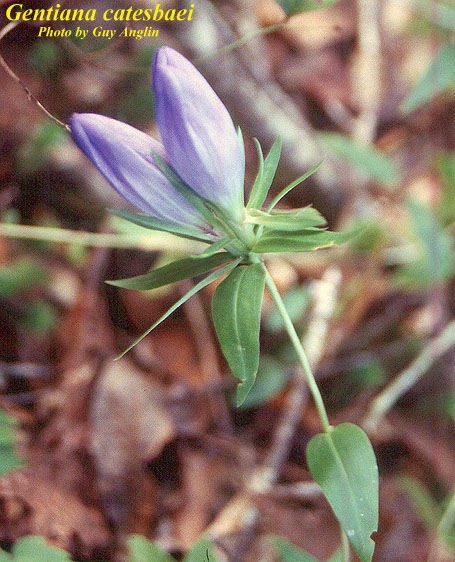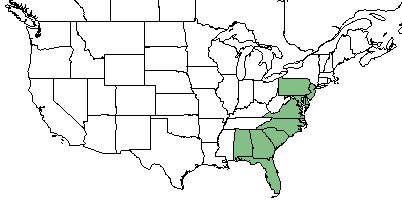Difference between revisions of "Gentiana catesbaei"
(→Ecology) |
|||
| Line 30: | Line 30: | ||
==Ecology== | ==Ecology== | ||
===Habitat=== <!--Natural communities, human disturbed habitats, topography, hydrology, soils, light, fire regime requirements for removal of competition, etc.--> | ===Habitat=== <!--Natural communities, human disturbed habitats, topography, hydrology, soils, light, fire regime requirements for removal of competition, etc.--> | ||
| − | ''G. catesbaei'' can be found in "pocosins, moist longleaf pine savanna edges, edges of moist hardwood forests, bluff seepages" <ref name="Weakley"/>. Habitat typically has saturated, loamy, peat soil <ref name="Herbarium/>. | + | ''G. catesbaei'' can be found in "pocosins, moist longleaf pine savanna edges, edges of moist hardwood forests, bluff seepages" <ref name="Weakley"/>. Habitat typically has saturated, loamy, peat soil <ref name="Herbarium>Florida State University Robert K. Godfrey Herbarium database. URL: http://herbarium.bio.fsu.edu. Last accessed: May 2018. Collectors: Loran C. Anderson, R. K. Godfrey, A. Gholson Jr., D. C. Vickers, Steve N. Jones, Rodie White, R. Komarek and |
| + | R. Kral. States and Counties: Alabama: Covington and Coffee. Georgia: Grady and Thomas. Florida: Leon, Gadsden, and Wakulla. </ref>. | ||
===Phenology=== <!--Timing off flowering, fruiting, seed dispersal, and environmental triggers. Cite PanFlora website if appropriate: http://www.gilnelson.com/PanFlora/ --> | ===Phenology=== <!--Timing off flowering, fruiting, seed dispersal, and environmental triggers. Cite PanFlora website if appropriate: http://www.gilnelson.com/PanFlora/ --> | ||
| − | ''G. catesbaei'' typically flowers from late September through November<ref name="Weakley">Weakley, A. S. (2015). Flora of the Southern and Mid-Atlantic States. Chapel Hill, NC, University of North Carolina Herbarium.</ref>, but can still have flowers present through mid-December <ref name= "Herbarium" | + | ''G. catesbaei'' typically flowers from late September through November<ref name="Weakley">Weakley, A. S. (2015). Flora of the Southern and Mid-Atlantic States. Chapel Hill, NC, University of North Carolina Herbarium.</ref>, but can still have flowers present through mid-December <ref name= "Herbarium"/>. |
<!--===Seed dispersal===--> | <!--===Seed dispersal===--> | ||
<!--===Seed bank and germination===--> | <!--===Seed bank and germination===--> | ||
Revision as of 12:57, 22 May 2018
| Gentiana catesbaei | |
|---|---|

| |
| Photo by the Atlas of Florida Plants Database | |
| Scientific classification | |
| Kingdom: | Plantae |
| Division: | Magnoliophyta - Flowering plants |
| Class: | Magnoliopsida - Dicots |
| Order: | Gentianales |
| Family: | Gentianaceae |
| Genus: | Gentiana |
| Species: | G. catesbaei |
| Binomial name | |
| Gentiana catesbaei Walter | |

| |
| Natural range of Gentiana catesbaei from USDA NRCS Plants Database. | |
Contents
Taxonomic Notes
Synonyms: none.
Varieties: none.
Description
G. catesbaei is a perennial forb native to the southeast United States [1].
Distribution
Ecology
Habitat
G. catesbaei can be found in "pocosins, moist longleaf pine savanna edges, edges of moist hardwood forests, bluff seepages" [2]. Habitat typically has saturated, loamy, peat soil [3].
Phenology
G. catesbaei typically flowers from late September through November[2], but can still have flowers present through mid-December [3].
Conservation and Management
Cultivation and restoration
Photo Gallery
References and notes
- ↑ USDA Plants Database URL: https://plants.usda.gov/core/profile?symbol=GECA10
- ↑ 2.0 2.1 Weakley, A. S. (2015). Flora of the Southern and Mid-Atlantic States. Chapel Hill, NC, University of North Carolina Herbarium.
- ↑ 3.0 3.1 Florida State University Robert K. Godfrey Herbarium database. URL: http://herbarium.bio.fsu.edu. Last accessed: May 2018. Collectors: Loran C. Anderson, R. K. Godfrey, A. Gholson Jr., D. C. Vickers, Steve N. Jones, Rodie White, R. Komarek and R. Kral. States and Counties: Alabama: Covington and Coffee. Georgia: Grady and Thomas. Florida: Leon, Gadsden, and Wakulla.